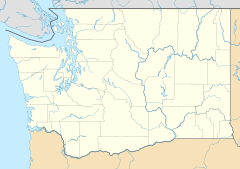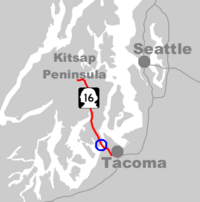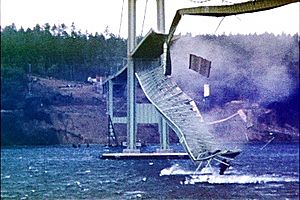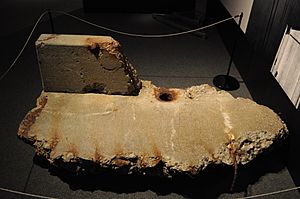Tacoma Narrows Bridge (1940) facts for kids
Quick facts for kids Tacoma Narrows Bridge |
|
|---|---|
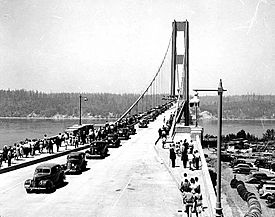
Opening day of the Tacoma Narrows Bridge, Tacoma, Washington, July 1, 1940
|
|
| Coordinates | 47°16′00″N 122°33′00″W / 47.26667°N 122.55000°W |
| Other name(s) | Galloping Gertie |
| Characteristics | |
| Design | Suspension |
| Total length | 5,939 feet (1,810.2 m) |
| Longest span | 2,800 feet (853.4 m) |
| Clearance below | 195 feet (59.4 m) |
| History | |
| Opened | July 1, 1940 |
| Collapsed | November 7, 1940 |
The 1940 Tacoma Narrows Bridge was a famous suspension bridge in the state of Washington, United States. It was built across the Tacoma Narrows strait of Puget Sound, connecting the city of Tacoma with the Kitsap Peninsula. The bridge opened on July 1, 1940. Sadly, it collapsed into Puget Sound just over four months later, on November 7, 1940.
At the time it was built, it was the third-longest suspension bridge in the world. Only the Golden Gate Bridge and the George Washington Bridge were longer.
Building the bridge started in September 1938. Once the main part of the bridge, called the deck, was built, people noticed something strange. The wind made the deck move up and down a lot. Because of this bouncy movement, people gave the bridge a funny nickname: Galloping Gertie. Even when the bridge opened to the public, it still moved a lot. Many attempts were made to stop the movement, but none of them worked. The bridge's main section finally collapsed in winds of about 40-mile-per-hour (64 km/h) on the morning of November 7, 1940.
Because of World War II, the bridge could not be rebuilt right away. The tall towers and strong cables of the bridge were still standing. But these parts, along with the rest of the bridge, were taken apart. The metal was sold as scrap metal. In 1950, a new Tacoma Narrows Bridge was built in the same spot. It even used some of the original bridge's foundations. The parts of the bridge that fell into the water now form an artificial reef, providing a home for sea creatures.
The collapse of the Tacoma Narrows Bridge had a big impact on science and engineering. It is often used in physics books to explain a concept called resonance. Its collapse also led to much more research into how bridges react to wind, a field called bridge aerodynamics or aeroelastics. This research has changed how all large, long-span bridges around the world have been designed since 1940.
Contents
Building the Bridge: Design and Construction
People had wanted a bridge connecting Tacoma and the Kitsap Peninsula since the late 1800s. In 1889, a railway company even thought about building a trestle there. Later, in 1923, the Tacoma Chamber of Commerce started trying to get money to build a bridge. They talked to many famous bridge engineers, like Joseph B. Strauss (who designed the Golden Gate Bridge) and David B. Steinman.
Getting enough money to pay for the bridge was a big challenge from the start. The money collected from tolls (fees to cross the bridge) would not be enough to cover the building costs. However, the U.S. Navy and Army supported the bridge. They had important bases nearby, and the bridge would help them move people and supplies.
Clark Eldridge, an engineer for the state, created a design for a suspension bridge. This design was similar to other successful bridges. However, Leon Moisseiff, a well-known bridge engineer from New York, had different ideas. He was a designer for the Golden Gate Bridge. Moisseiff suggested a way to build the bridge for less money. He proposed using shallower supports, called girders, that were only 8 feet (2.4 m) deep, instead of the 25 feet (7.6 m) deep ones Eldridge suggested. Moisseiff's design made the bridge slimmer and cheaper to build.
His design was chosen, and construction began on September 27, 1938. The bridge was built very quickly, taking only nineteen months. It cost $6.4 million. With a main span of 2,800 feet (850 m), the Tacoma Narrows Bridge was the third-longest suspension bridge in the world at that time.
Because people didn't expect a lot of traffic, the bridge was designed with only two lanes. It was quite narrow, at just 39 feet (12 m) wide, especially for its length. With only the 8 feet (2.4 m)-deep girders for support, the bridge's roadway was very shallow.
These shallow and narrow girders were a big reason why the bridge collapsed. The deck of the bridge was not stiff enough. It was easily moved by the wind. The bridge became famous for its movement. Even a small wind could make the center section move several feet up and down every few seconds. Workers saw this during construction and nicknamed it "Galloping Gertie." The public also felt these movements when the bridge opened on July 1, 1940.
Another problem was that the bridge had solid sides. This design didn't let the wind pass through the bridge's deck. Instead, the wind pushed against the bridge, causing it to sway and eventually fall.
Trying to Stop the Movement
Because the bridge moved so much during its construction, many ideas were tried to make it more stable. These included:
- Adding cables from the girders to heavy 50 ton[convert: unit invalid here] concrete blocks on the shore. This didn't work, as the cables broke soon after they were added.
- Adding cable stays, which connected the main cables to the bridge deck in the middle. These were in place until the collapse but did not reduce the bridge's movement.
- Adding hydraulic buffers between the towers and the deck. This system was meant to lessen the movement but was damaged before it could be fully useful.
The Washington Toll Bridge Authority hired Professor Frederick Burt Farquharson from the University of Washington. He used a wind-tunnel to test models of the bridge. He built a small model (1:200 scale) of the whole bridge and a larger model (1:20 scale) of a section of the deck. His first studies finished just five days before the bridge collapsed.
He found two possible ways to fix the problem:
- Make holes in the side girders and along the deck. This would let air flow through and reduce the forces from the wind.
- Give the deck a more aerodynamic shape by adding special parts called fairings or deflector vanes.
The first idea was not liked because the changes would be permanent. The second idea was chosen, but it was never put into action because the bridge collapsed five days later.
The Collapse of Galloping Gertie
The bridge collapsed on November 7, 1940, at 11:00 a.m. (Pacific time). The collapse was caused by a physical event known as aeroelastic flutter, which is when wind causes a structure to vibrate in a way that makes the vibrations grow larger and larger.
Leonard Coatsworth, a newspaper editor, was the last person to drive on the bridge. He was driving with his dog, Tubby, when the bridge started to vibrate wildly. Coatsworth had to leave his car:
Just as I drove past the towers, the bridge began to sway violently from side to side. Before I realized it, the tilt became so violent that I lost control of the car...I jammed on the brakes and got out, only to be thrown onto my face against the curb...Around me I could hear concrete cracking...The car itself began to slide from side to side of the roadway.
On hands and knees most of the time, I crawled 500 yards (460 m) or more to the towers...My breath was coming in gasps; my knees were raw and bleeding, my hands bruised and swollen from gripping the concrete curb...Toward the last, I risked rising to my feet and running a few yards at a time...Safely back at the toll plaza, I saw the bridge in its final collapse and saw my car plunge into the Narrows.
No people died when the bridge collapsed. Tubby, a black male cocker spaniel, was the only life lost in the Tacoma Narrows Bridge disaster. The dog was trapped in Coatsworth's car. Professor Farquharson and a news photographer tried to save Tubby, but the dog was too scared to leave the car. He even bit one of the people trying to rescue him. Tubby died when the bridge fell. Neither his body nor the car were ever found. Coatsworth was paid US $450 for his car and $364.40 for the items inside, which included Tubby.
What Happened After the Collapse?
Experts, including Theodore von Kármán, a famous aerodynamicist, investigated what caused the bridge to fall. There were some problems with the bridge's insurance payments, but most of the insurance money was paid without issues.
On November 28, 1940, the U.S. Navy reported that the parts of the bridge were lying at the bottom of the water at coordinates 47°16′00″N 122°33′00″W / 47.26667°N 122.55000°W, about 180 feet (55 meters) deep.
Efforts to save the bridge continued until May 1943. It was decided that the bridge could not be fixed. The entire bridge would have to be taken down, and a new one built. However, the United States was in World War II at the time. The steel needed for a new bridge was needed for the war effort. The steel from the old bridge's cables and main span was sold to be melted down. It actually cost the state more money to take down the bridge than it earned from selling the materials.
The parts of the bridge that fell into the water are now a large artificial reef. They are listed on the National Register of Historic Places, which means they are important historical sites.
A Lesson for Future Bridges
Othmar Ammann, a leading bridge designer and a member of the group that studied the collapse, wrote about what was learned:
The Tacoma Narrows bridge failure has given us invaluable information...It has shown [that] every new structure [that] projects into new fields of magnitude involves new problems for the solution of which neither theory nor practical experience furnish an adequate guide. It is then that we must rely largely on judgement and if, as a result, errors, or failures occur, we must accept them as a price for human progress.
This means that building very large, new structures can bring unexpected challenges. When mistakes happen, we learn from them, and this helps human progress.
The Bronx Whitestone Bridge in New York, which had a similar design to the 1940 Tacoma Narrows Bridge, was strengthened after the collapse. Steel structures were added to its sides in 1943 to make it heavier and stiffer. This helped reduce its oscillation (swinging). In 2003, these steel structures were removed, and new, more aerodynamic parts were added to the sides of the bridge deck.
New Bridges for Tacoma Narrows
Because of the war, it took 10 years before a new bridge was opened. This new bridge opened to traffic on October 14, 1950. It is 5,979 feet (1,822 m) long, which is 40 feet (12 m) longer than "Galloping Gertie." The new bridge also has more lanes than the original.
About 50 years later, the new bridge had too much traffic. So, a second, parallel suspension bridge was built next to it. This new bridge carries traffic going east. The bridge built in 1950 was then changed to only carry traffic going west. The newest bridge opened in July 2007.
Images for kids
See also
 In Spanish: Puente de Tacoma (1940) para niños
In Spanish: Puente de Tacoma (1940) para niños


